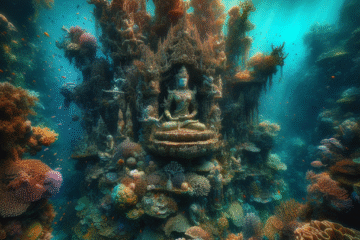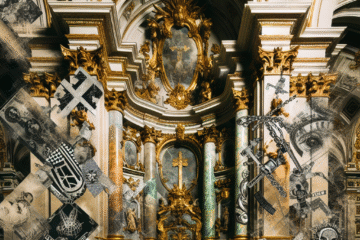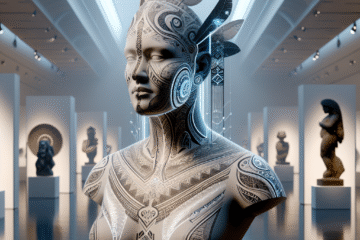I. Introduction
- Definition of Artificial Intelligence (AI)
- Definition of Art
- Brief overview of the intersection of AI and art
Artificial Intelligence, or AI, is the simulation of human intelligence in machines that are programmed to think and learn like humans. It encompasses a wide range of technologies, including machine learning, natural language processing, and computer vision. The goal of AI is to create machines that can perform tasks that typically require human intelligence, such as understanding speech, recognizing images, and making decisions.
Art, on the other hand, is a diverse field that encompasses various forms of human expression, including visual art, music, literature, and performance. Art is often created to evoke emotion or convey a message, and it can take many forms, from traditional painting and sculpture to digital media and performance art.
The intersection of AI and art is a relatively new and rapidly evolving field that explores the potential of AI technologies to create, interpret, and understand art. This intersection has led to the development of new forms of art, such as generative art and digital painting, as well as new ways of understanding and interpreting existing artworks.
In recent years, AI has been used to create art in various forms, from music to visual art. Generative art, for example, is a form of art created by algorithms, in which the artist sets certain parameters and the AI generates the final artwork. Another example is digital painting, where AI is used to create digital paintings, mimicking the style of human painters.
Moreover, AI is also used to interpret art, to understand the meaning behind the work, and to generate new artworks that are influenced by existing artworks. AI-powered applications such as DeepArt and Ostagram allow users to upload a photo and have it transformed into a style of a famous artist, such as Van Gogh or Monet.
The intersection of AI and art raises many important questions, such as the definition of art and the question of authorship. Who is the author of an artwork created by AI? Is it the person who programmed the algorithm or the machine that created the work? And is it possible for a machine to truly understand or create art in the same way that humans do?
Despite these challenges, the intersection of AI and art has the potential to create new forms of art and new ways of understanding and interpreting existing art. As technology continues to advance and AI becomes more sophisticated, it will be exciting to see how this intersection continues to evolve and shape the world of art.
II. History of AI and Art
- Early examples of AI in art
- Evolution of AI in art over time
The history of AI and art is a relatively short one, but it has been marked by significant advancements and milestones. One of the earliest examples of AI in art is the work of artist and computer scientist Vera Molnar, who began experimenting with computer-generated art in the 1960s. Molnar used early computer programs to create geometric abstractions that were printed out on paper.
In the 1970s and 1980s, artists such as Harold Cohen and Michael Noll began using early AI systems to create visual art. Cohen’s program, AARON, was designed to create abstract drawings, while Noll’s system was used to create digital images. Both artists developed their programs to have some level of autonomy, meaning they could create new images without human input.
In the 1990s, the field of AI and art began to evolve more rapidly. Artists such as Golan Levin began to use more advanced AI systems to create interactive installations. In addition, the field of generative art, in which algorithms are used to create new artworks, began to emerge. Artists such as Joshua Davis and Golan Levin began creating digital artworks that were generated by algorithms.
In the 2000s, the intersection of AI and art continued to evolve with the advent of machine learning. Artists such as Zach Lieberman and Rafael Lozano-Hemmer began using machine learning algorithms to create interactive installations that respond to the audience. Another example is the artist Joshua Davis, who uses a technique called “genetic algorithms” to create generative artworks.
Recent years have seen the introduction of deep learning techniques, which have allowed for more sophisticated AI-generated artworks. For example, several AI-powered applications such as Ostagram and DeepArt have been developed that allow users to upload a photo and have it transformed into the style of a famous artist.
Overall, the history of AI and art has been marked by a steady evolution of technology and the increasing sophistication of AI systems. As technology continues to advance, it is likely that we will see even more exciting developments in the field of AI and art in the future.
It is important to note that, despite the evolution of technology, the intersection of AI and art raises important questions about the definition of art and the question of authorship. The question of whether a machine can truly understand or create art in the same way that humans do is still a topic of ongoing debate in the art world.
III. Current Applications of AI in Art
- Generative art
- Digital painting and drawing
- Music and sound generation
- Performance art and installation
The intersection of AI and art has led to the development of a number of exciting new applications. One of the most notable is generative art, in which algorithms are used to create new artworks. Generative art can take many forms, from digital images and animations to interactive installations.
One example of generative art is the work of Joshua Davis, an artist who uses genetic algorithms to create digital images. Genetic algorithms are a type of machine learning algorithm that mimic the process of natural selection. Davis creates a set of rules for his algorithms and then allows them to evolve over time, resulting in unique and complex images.
Another application of AI in art is digital painting and drawing. Artists such as Golan Levin and Zach Lieberman have used AI to create digital paintings that mimic the style of human artists. For example, AI-powered applications such as Ostagram and DeepArt allow users to upload a photo and have it transformed into the style of a famous artist, such as Van Gogh or Monet.
In addition to visual art, AI is also being used to create music and sound. For example, AI-powered music composition software such as Amper Music and Jukedeck have been developed to generate unique and original music tracks. These programs are able to analyze existing music and generate new tracks that are similar in style.
AI is also being used in performance art and installation. For example, artists such as Zach Lieberman and Rafael Lozano-Hemmer have created interactive installations that respond to the audience. Lieberman’s “EyeWriter” is an interactive installation that tracks the movement of the viewer’s eyes and generates images in real-time.
In summary, the intersection of AI and art has led to the development of a wide range of exciting new applications, including generative art, digital painting and drawing, music and sound generation, and performance art and installation. As technology continues to advance, it is likely that we will see even more innovative applications of AI in art in the future.
IV. Challenges and Criticisms
- Ethical considerations
- Impact on the art world and artists
- The question of authorship and originality
The intersection of AI and art raises a number of important challenges and criticisms. One of the main challenges is the ethical considerations surrounding the use of AI in art. For example, some critics argue that the use of AI to create art devalues the role of the human artist and diminishes the importance of human creativity. Others argue that the use of AI in art raises questions about the definition of art and the question of authorship.
Another major criticism of AI in art is the impact it has on the art world and artists. Some argue that the use of AI to create art could lead to a decrease in the value of human-created art, making it harder for human artists to make a living. Additionally, the use of AI to create art could also lead to the homogenization of art, as algorithms and AI systems could be used to create art that is similar in style and content.
Another important consideration is the question of authorship and originality. When an artwork is created by an AI system, it raises questions about who should be credited as the author of the work. Is it the person who programmed the algorithm or the machine that created the work? This question is particularly relevant in the context of copyright law, as it is not clear who owns the rights to an artwork created by AI.
Moreover, there is also a question of whether AI can truly understand or create art in the same way that humans do. Some argue that AI-generated art lacks the emotional depth and meaning of human-created art, while others argue that AI has the potential to create new forms of art that are not possible with human creativity alone.
Despite these challenges, it’s important to note that AI and art have the potential to create new forms of art and new ways of understanding and interpreting existing art. It’s important to consider these challenges and criticisms when exploring the intersection of AI and art, but also to keep an open mind about the potential of AI and art to create new and exciting forms of human expression.
V. Future of AI and Art
- Predictions for the future of AI in art
- Potential impact on the industry and society
The future of AI and art is an exciting and rapidly evolving field, with many predictions for how it will continue to shape the world of art. As technology continues to advance, it is likely that we will see even more sophisticated AI systems that are able to create even more complex and nuanced artworks.
One prediction for the future of AI and art is that we will see an increase in the use of AI in the art market. AI-powered applications and algorithms could be used to help buyers and sellers navigate the art market, making it easier for people to find, purchase and sell art. This could have a significant impact on the art industry, making it more accessible to a wider range of people.
Another prediction is that we will see more AI-generated artworks that are indistinguishable from human-created art. As AI systems continue to improve, they will be able to create art that is more complex and nuanced, making it harder to tell the difference between AI-generated art and human-created art. This could lead to a blurring of the lines between human and machine-created art and change the way we think about art.
Moreover, the use of AI in art is expected to have a positive impact on society by making art more accessible to everyone. For example, AI-powered art-making tools could be used to help people with disabilities or other challenges create art. Also, AI could be used to create art that is personalized to the viewer, providing a more immersive and engaging experience.
It’s important to note that, despite these predictions, the future of AI and art is still uncertain. There are many challenges and criticisms surrounding the use of AI in art, and it will be important to continue to consider these issues as the field evolves.
Overall, the future of AI and art is an exciting and rapidly evolving field, with many predictions for how it will continue to shape the world of art. From increasing accessibility to the art market to creating personalized art experiences, the use of AI in art has the potential to have a significant impact on the industry and society.
VI. Conclusion
- Summary of the intersection of AI and art
- The significance of the intersection in today’s world
- Final thoughts and recommendations for further exploration.
In conclusion, the intersection of AI and art is a rapidly evolving field that explores the potential of AI technologies to create, interpret, and understand art. It has led to the development of new forms of art, such as generative art and digital painting, as well as new ways of understanding and interpreting existing artworks.
The history of AI and art is relatively short but marked by significant advancements and milestones. From early examples of AI in art in the 1960s to recent developments in deep learning, AI and art have evolved together. However, this intersection raises many important questions, such as the definition of art and the question of authorship. Who is the author of an artwork created by AI? Is it the person who programmed the algorithm or the machine that created the work? And is it possible for a machine to truly understand or create art in the same way that humans do?
Despite these challenges, the intersection of AI and art has the potential to create new forms of art and new ways of understanding and interpreting existing art. As technology continues to advance and AI becomes more sophisticated, it will be exciting to see how this intersection continues to evolve and shape the world of art.
The significance of the intersection of AI and art in today’s world is that it has the potential to make art more accessible to everyone and to change the way we think about art and creativity. It also has the potential to create new forms of art that are not possible with human creativity alone.
In terms of recommendations for further exploration, it would be interesting to continue to explore the ethical considerations surrounding the use of AI in art and to consider the impact of AI on the art industry and society. Additionally, it would be beneficial to continue to explore the question of authorship and originality in the context of AI-generated art and to consider the ways in which AI can be used to make art more accessible to a wider range of people.
In conclusion, the intersection of AI and art is an exciting and rapidly evolving field that has the potential to shape the future of art and creativity. As technology continues to advance, it will be interesting to see how this intersection continues to evolve and impact the world of art.


